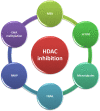Potential of histone deacetylase inhibitors in the control and regulation of prostate, breast and ovarian cancer
- PMID: 36034650
- PMCID: PMC9411967
- DOI: 10.3389/fchem.2022.948217
Potential of histone deacetylase inhibitors in the control and regulation of prostate, breast and ovarian cancer
Abstract
Histone deacetylases (HDACs) are enzymes that play a role in chromatin remodeling and epigenetics. They belong to a specific category of enzymes that eliminate the acetyl part of the histones' -N-acetyl lysine, causing the histones to be wrapped compactly around DNA. Numerous biological processes rely on HDACs, including cell proliferation and differentiation, angiogenesis, metastasis, gene regulation, and transcription. Epigenetic changes, specifically increased expression and activity of HDACs, are commonly detected in cancer. As a result, HDACi could be used to develop anticancer drugs. Although preclinical outcomes with HDACs as monotherapy have been promising clinical trials have had mixed results and limited success. In both preclinical and clinical trials, however, combination therapy with different anticancer medicines has proved to have synergistic effects. Furthermore, these combinations improved efficacy, decreased tumor resistance to therapy, and decreased toxicity. In the present review, the detailed modes of action, classification of HDACs, and their correlation with different cancers like prostate, breast, and ovarian cancer were discussed. Further, the different cell signaling pathways and the structure-activity relationship and pharmaco-toxicological properties of the HDACi, and their synergistic effects with other anticancer drugs observed in recent preclinical and clinical studies used in combination therapy were discussed for prostate, breast, and ovarian cancer treatment.
Keywords: HDAC inhibitors (HDACi); Histone deacetylase (HDAC); breast cancer; ovarian cancer; prostate cancer.
Copyright © 2022 Pramanik, Kumar Halder, Mukherjee, Kumar, Dey and R.
Conflict of interest statement
The authors declare that the research was conducted in the absence of any commercial or financial relationships that could be construed as a potential conflict of interest.
Figures





References
-
- Aggarwal R. R., Schweizer M. T., Nanus D. M., Pantuck A. J., Heath E. I., Campeau E., et al. (2020). A phase Ib/IIa study of the pan-BET inhibitor ZEN-3694 in combination with enzalutamide in patients with metastatic castration-resistant prostate cancer. Clin. Cancer Res. 26 (20), 5338–5347. 10.1158/1078-0432.ccr-20-1707 - DOI - PMC - PubMed
-
- Amengual J. E., Johannet P., Lombardo M., Zullo K., Hoehn D., Bhagat G., et al. (2015). Dual targeting of protein degradation pathways with the selective HDAC6 inhibitor ACY-1215 and bortezomib is synergistic in lymphoma. Clin. Cancer Res. 21, 4663–4675. 10.1158/1078-0432.ccr-14-3068 - DOI - PMC - PubMed
-
- Andrade S. N., Evangelista F. C. G., Seckler D., Marques D. R., Freitas T. R., Nunes R. R., et al. (2018). Synthesis, cytotoxic activity, and mode of action of new Santacruzamate A analogs. Med. Chem. Res. 27 (11-12), 2397–2413. 10.1007/s00044-018-2244-3 - DOI
Publication types
LinkOut - more resources
Full Text Sources
Research Materials

